Cytoplasma Studienführer, Klassennotizen & Zusammenfassungen
Suchst du nach den besten Studienführern, Studiennotizen und Zusammenfassungen über Cytoplasma? Auf dieser Seite findest du 97 Studienunterlagen zu Cytoplasma.
Seite 4 aus 97 Ergebnisse
Sortieren nach
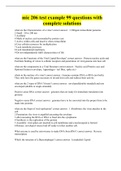
-
mic 206 test example 99 questions with complete solutions
- Prüfung • 11 Seiten • 2022
-
Im Paket-Deal erhältlich
-
- 10,07 €
- + erfahre mehr
what are the Characteristics of a virus? correct answer: 1 Obligate intracellular parasites 2 Small - 20 to 200 nm 3 Acellular 4 Made of nucleic acid surrounded by protein coat 5 Active within cells and inactive when extracellular 6 Uses cellular resources for multiplication 7 Lack metabolic processes 8 Lack translational machinery 9 Do not independently fulfil characteristics of life what are the Functions of the Viral Capsid/Envelope? correct answer: Protects nucleic acids and Fac...
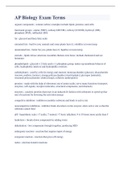
-
AP Biology Exam Terms Latest Updates 2023
- Prüfung • 16 Seiten • 2023
-
Im Paket-Deal erhältlich
-
- 11,03 €
- + erfahre mehr
AP Biology Exam Terms organic compounds - contain carbon; examples include lipids, proteins, and carbs functional groups - amino (NH2), carbonyl (RCOR), carboxyl (COOH), hydroxyl (OH), phosphate (PO4), sulfhydryl (SH) fat - glycerol and three fatty acids saturated fats - bad for you; animals and some plants have it; solidifies at room temp. unsaturated fats - better for you, plants have it; liquifies at room temp. steriods - lipids whose structures resemble chicken-wire fence. ...
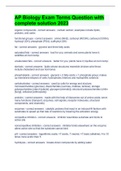
-
AP Biology Exam Terms Question with complete solution 2023
- Prüfung • 19 Seiten • 2023
-
Im Paket-Deal erhältlich
-
- 16,80 €
- + erfahre mehr
AP Biology Exam Terms Question with complete solution 2023organic compounds contain carbon; examples include lipids, proteins, and carbs functional groups amino (NH2), carbonyl (RCOR), carboxyl (COOH), hydroxyl (OH), phosphate (PO4), sulfhydryl (SH) fat glycerol and three fatty acids saturated fats bad for you; animals and some plants have it; solidifies at room temp. unsaturated fats better for you, plants have it; liquifies at room temp. steriods lipids...
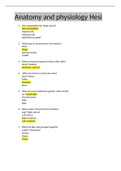
-
Anatomy and physiology Hesi
- Prüfung • 4 Seiten • 2023
-
- 11,51 €
- + erfahre mehr
Anatomy and physiology Hesi 1. Skin responsible fokr finger prints? Dermal papillase Markel cells Amectors pili Sudoriferous gland 2. What type of synovia joint is the elbow? Pivot Hinge Ball and socket Toddle 3. Where is blood produced infants after birth? Heart chamber Red bone marrow 4. What structure is a ball and socket joint? Elbow Ankle Shoulder Knee 5. what are macromolecules genetic code carried on? Nucleotide Chromosomes DNA RNA 6. What cavity of heart has the t...
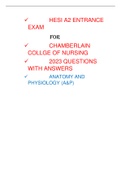
-
HESI A2 ENTRANCE A&P 2023
- Prüfung • 86 Seiten • 2023
-
Im Paket-Deal erhältlich
-
- 16,80 €
- + erfahre mehr
HESI A2 ENTRANCE EXAM FOR CHAMBERLAIN COLLGE OF NURSING 2023 QUESTIONS WITH ANSWERS ANATOMY AND PHYSIOLOGY (A&P) Which is an anterior muscle? A. Gluteus maximus B. Quadriceps femoris C. Biceps femoris D. Adductor magnus How might the headrest on a car prevent traumatic injury? A. By limiting hyperflexion of the neck B. By limiting hyperextension of the neck C. By reducing vertebral compression D. By preventing disc degeneration Which might you expect to s...

Angst, etwas zu verpassen? Dann tu es nicht!

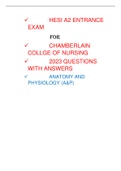
-
HESI A2 ANATOMY AND PHYSIOLOGY ENTRANCE EXAM
- Prüfung • 86 Seiten • 2023
-
- 16,22 €
- + erfahre mehr
HESI A2 ENTRANCE EXAM HESI A2 ENTRANCE EXAM FOR CHAMBERLAIN COLLGE OF NURSING 2023 QUESTIONS WITH ANSWERS ANATOMY AND PHYSIOLOGY (A&P) Which is an anterior muscle? A. Gluteus maximus B. Quadriceps femoris C. Biceps femoris D. Adductor magnus How might the headrest on a car prevent traumatic injury? A. By limiting hyperflexion of the neck B. By limiting hyperextension of the neck C. By reducing vertebral compression D. By preventing disc degeneration Which ...
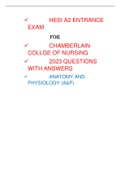
-
HESI A2 ENTRANCE EXAM FOR CHAMBERLAIN COLLGE OF NURSING 2023 QUESTIONS WITH ANSWERS ANATOMY AND PHYSIOLOGY (A&P
- Prüfung • 86 Seiten • 2022
-
- 28,32 €
- + erfahre mehr
HESI A2 ENTRANCE EXAM FOR CHAMBERLAIN COLLGE OF NURSING 2023 QUESTIONS WITH ANSWERS ANATOMY AND PHYSIOLOGY (A&P) Which is an anterior muscle? A. Gluteus maximus B. Quadriceps femoris C. Biceps femoris D. Adductor magnus How might the headrest on a car prevent traumatic injury? A. By limiting hyperflexion of the neck B. By limiting hyperextension of the neck C. By reducing vertebral compression D. By preventing disc degeneration Which might you expect to see i...
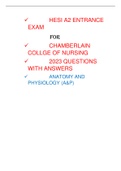
-
HESI A2 ENTRANCE EXAM FOR CHAMBERLAIN COLLGE OF NURSING 2023 QUESTIONS WITH ANSWERS ANATOMY AND PHYSIOLOGY (A&P
- Prüfung • 86 Seiten • 2022
-
- 28,32 €
- + erfahre mehr
HESI A2 ENTRANCE EXAM FOR CHAMBERLAIN COLLGE OF NURSING 2023 QUESTIONS WITH ANSWERS ANATOMY AND PHYSIOLOGY (A&P) Which is an anterior muscle? A. Gluteus maximus B. Quadriceps femoris C. Biceps femoris D. Adductor magnus How might the headrest on a car prevent traumatic injury? A. By limiting hyperflexion of the neck B. By limiting hyperextension of the neck C. By reducing vertebral compression D. By preventing disc degeneration Which might you expect to see i...
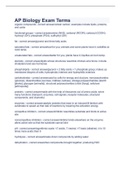
-
P Biology Exam Terms 2023 with complete solution questions and answers
- Prüfung • 19 Seiten • 2023
-
- 10,55 €
- + erfahre mehr
organic compounds contain carbon; examples include lipids, proteins, and carbs functional groups amino (NH2), carbonyl (RCOR), carboxyl (COOH), hydroxyl (OH), phosphate (PO4), sulfhydryl (SH) fat glycerol and three fatty acids saturated fats bad for you; animals and some plants have it; solidifies at room temp. unsaturated fats better for you, plants have it; liquifies at room temp. steriods lipids whose structures resemble chicken-wire fence. include cho...
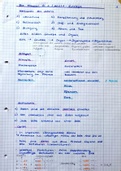
-
Thema Zytologie und Enzyme, vollständige Abitur Zusammenfassung
- Zusammenfassung • 21 Seiten • 2021
- Im Paket-Deal erhältlich
-
- 2,99 €
- + erfahre mehr
vollständige Abitur Zusammenfassung des Themas Zytologie und Enzyme. Geeignet für Klausuren und Schriftliches, sowie mündliches Abitur. Enthält alle Aspekte des Themas aus dem Bildungsplan Baden- Württemberg. Abiturschnitt 1,0

Fragst du dich auch, warum so viele deiner Kommilitonen coole Klamotten tragen, zum Ende des Monats noch Geld zur Verfügung haben und gleichzeitig ihre Freizeit genießen? Nun, sie verkaufen auf Stuvia! Stell dir vor, deine Studienunterlagen werden ein Dutzend Mal für je 15 € heruntergeladen. Jeden. Einzelnen. Tag. Entdecke alles über Verdienstmöglichkeiten auf Stuvia
